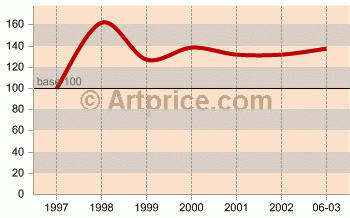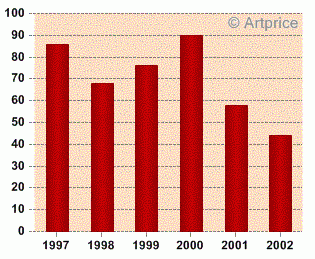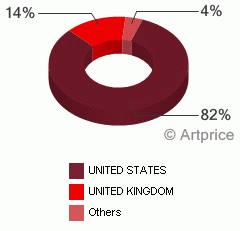James Rosenquist (1933)
[29 Oct 2003]
Rosenquist has one of the lowest price indexes among pop artists. The retrospective at the Guggenheim Museum might create renewed interest.
In 1948, at the age of 15, James Rosenquist entered the Minneapolis School of Art. Later he studied at the University of Minnesota, and then in New York in 1955, where he met Robert Indiana. At the end of the 1950s he met a number of the future stars of Pop Art, including Ellsworth Kelly, Jasper Johns, Robert Rauschenberg and Claes Oldenburg. After leaving the Artkraft Strauss Sign Corporation in 1959, he started painting juxtapositions of images in large formats using commercial painting techniques. In 1962, the Green Gallery gave him his first private exhibition. His fame rapidly grew. In 1963 he exhibited at MoMA and the Guggenheim Museum, and the following year he joined the Leo Castelli gallery. In 1965 he produced his first lithographs and created F-111, a 26-metre giant collage, which was exhibited at the International Pavilion of the Venice Biennale 13 years later. Rosenquist remained faithful to his technique over the years, concentrating on large canvasses, although he changed his themes frequently. After series such as Water Planet, Gift-Wrapped Doll, Anti-Gun and Singapore, his more recent works have become increasingly abstract , such as Speed of Light. The variety of his work is currently on show at a major retrospective at the Guggenheim Museum, until January 2004.
Artworks at auctions
This variety is reflected in sale prices: he set a record in 1986, with F-111, which Sotheby’s sold for just over USD 2 million. However, the price reached for this masterpiece was a one-off. No other painting has topped the USD 418,000 fetched by Blue Spark (1962). Rosenquist’s works from the 1960s remain the most sought after, but now rarely come up for auction—not one has been on offer for three years. As a result, when one does come up for sale, estimates are often exceeded. Only 5-10 paintings appear at auction each year, many of which are fresh paintings dating from the 1990s. Paintings such as Gift Wrapped Doll (1992-93) and large format paintings from the “gun” series have fetched just over USD 50,000. The market mostly consists of prints, representing 85% of lots on offer and almost a quarter of the artist’s turnover—with 60% selling for under EUR 1,000.
The market places
The multiples are mostly sold in the US, but also regularly appear in Germany and Sweden too. Although his originals are generally the preserve of US auctioneers, more works are now coming to Europe. In 2003, two works have been sold in the continent: Target in Paris, and Sieve – Spinning eye glass lense… in Milan.
Buy or sell
Rosenquist has one of the lowest price indexes among pop artists. The huge price gaps suggest considerable scope for Rosenquist’s prices to rise, especially as prices have remained relatively flat over the last four years. The retrospective might create renewed interest and allow the public to discover his diverse works. Because they are in limited supply, a Rosenquist painting has become a safe investment. The few works that have gone under the hammer have always found a buyer, with prices often exceeding expectations. As for his multiples, the early lithographs from the 1960s are still affordable: Whipped Butter for Eugene Ruchin, for example, from a collection of 200 from 1965, sold for USD 700 by Wright (Chicago).
James ROSENQUISTArtprice Indexall media categories, base January 1997 = 100  James ROSENQUISTLots sold at auctions
James ROSENQUISTLots sold at auctions  James ROSENQUISTAuction sales turnover 1999-2002 / weight by country
James ROSENQUISTAuction sales turnover 1999-2002 / weight by country  © Artprice
© Artprice




 0
0
